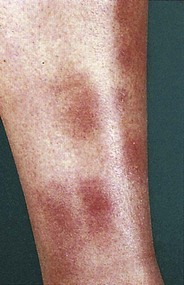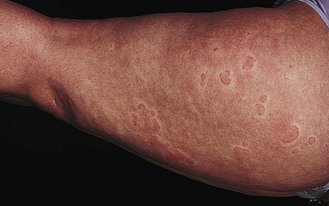17 Dermatology
A swollen red leg
What is your diagnosis?
Cellulitis, probably due to streptococci gaining entry via the venous ulcer.
Differential diagnosis
• Acute allergic contact dermatitis: e.g. to dressings
• Necrotising fasciitis: black necrotic areas within cellulitic area.
Leg ulceration
Management
• Venous ulcers: elevation, exercise, compression dressings. Antibiotics if infected (always check Doppler pressures before considering compression as many ulcers have mixed venous and arterial aetiology). Adequate analgesia.
• Arterial ulcers: investigate arterial supply, dressings with NO compression. Adequate analgesia.
• Vasculitic ulcers: vasculitic screen, e.g. ANCA, ANA, rheumatoid factor.
• Neuropathic ulcers: keep ulcer clean and remove pressure or trauma from affected area.
Note: Operating on varicose veins rarely helps venous insufficiency problems – ‘re-plumbing’ of the veins is not possible.
Erythema nodosum
It presents with painful, tender, dusky blue red nodules, usually on the shins and lower limbs (Fig 17.1).
Make the diagnosis
• Spontaneous onset over days; evolution over a few days or weeks
• Single or multiple deep bruise-like nodules 1–10 cm diameter (better felt than seen)
• Predominantly affecting limbs (shins or lower limbs)
• No age or sex limitation (but young females more common)
• Sometimes associated with arthralgia
Initial treatment
• Aspirin 600 mg as required (unless the identified cause of the EN).
• If severe symptoms and/or cutaneous ulceration, use dapsone (up to 100 mg daily)/steroids (30 mg daily decreasing course).
Note: monitor for haemolytic anaemia and avoid dapsone if G6PD deficient.
Urticaria and angio-oedema
Urticaria or hives is characterised by short-lived dermal swelling (weals) anywhere on the body (Fig. 17.2). These usually itch and, except in some subtypes, resolve without bruising within 24 h (often within 10–20 min). They can form bizarre serpiginous or annular-shaped lesions. The latter show central clearing, not central necrosis as seen in erythema multiforme.
Classification of urticarias
Acute
• Acute idiopathic urticaria and angio-oedema: accounts for > 90% of urticaria. A good history (not type 1 allergy testing) should exclude an allergic cause. Viral infections will sometimes set off an acute urticaria.
• Acute allergic: drug reactions, insect bites, foods (e.g. peanuts or seafood), can cause this type of reaction, as well as contact urticaria caused by, e.g. latex, tomatoes. A history of an almost immediate reaction (seconds to minutes) after contact with an allergen should alert one to this form.
General management
• Explanation of condition and likelihood of not identifying specific cause.
• Avoidance of non-specific factors, e.g. aspirin, NSAIDs, opiates.
• H1 anti-histamines (non-sedating or combination of daytime non-sedating H1 blockers and sedating H1 blocker at night); 90% of cases will respond to a non-sedating anti-histamine.
• H2 anti-histamines, e.g. cimetidine 400 mg × 2 daily.
Preferred regimes if no contraindications
• Loratidine 10–20 mg daily or cetirizine 10–20 mg daily or fexofenadine 180 mg daily (all non-sedating anti-histamines).
• Sedative anti-histamines, e.g. hydroxyzine 25–50 mg at night.
Refer: to dermatology department if no response to anti-histamines.





